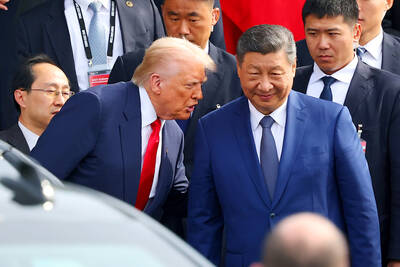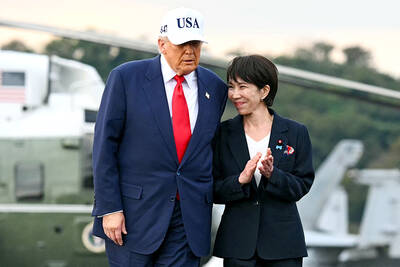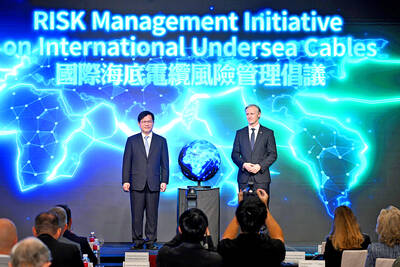US President Donald Trump is to skip two major summits in Asia in November, a move that could stoke concerns in the region about the US’ reliability as a counterweight to China.
The White House on Friday said that US Vice President Mike Pence would travel to Singapore for an 18-member ASEAN summit, before heading to Papua New Guinea for an APEC gathering.
The APEC summit is normally attended by 21 leaders, including Chinese President Xi Jinping (習近平) and Russian President Vladimir Putin.

Photo: Reuters
The decision removes one potential avenue for Trump to meet with Xi as a trade war between the US and China deepens. Both leaders are expected to attend the G20 summit in Argentina later in November.
Trump’s absence is also likely to fuel concerns among Asian leaders who want the US to push back against China’s increasing economic and military might.
Trump administration officials have been promoting a new “Indo-Pacific” strategy to bolster its commitment to the region, after Trump withdrew from the Trans-Pacific Partnership (TPP) trade deal and questioned the cost of security alliances with Japan and South Korea.
“His absence would doubtlessly solidify the impression that America has essentially abandoned its traditional presence in the Asia-Pacific, not to mention the non-starter Indo-Pacific,” said Oh Ei Sun (胡逸山), a senior adviser for international affairs at the Asian Strategy and Leadership Institute in Kuala Lumpur.
Without Trump, Xi would have more space to advocate Chinese trade and development projects, such as his ambitious Belt and Road Initiative.
Xi was the first leader to confirm his attendance to the APEC meeting in Port Moresby, Papua New Guinea, where he also plans to host his own summit with Pacific leaders.
Although US leaders have attended the events over the past few years, missing them is not unprecedented.
In 2007, then-US president George W. Bush drew flak for rescheduling a planned meeting with ASEAN leaders in Singapore. Former US president Barack Obama, whose administration announced a pivot in military and diplomatic resources to Asia, in 2013 skipped APEC to handle a government shutdown.
Newly installed Australian Prime Minister Scott Morrison during a trip to Jakarta yesterday told reporters that Trump’s decision to tend to matters at home was understandable and Pence “speaks with the authority of the [US] president.”
The Singaporean Ministry of Foreign Affairs welcomed Pence’s visit to the city-state, adding in a statement that it would be his first as US vice president.
The Asian summits come days after midterm US Congressional elections, which could determine Trump’s ability to withstand investigations into Russian campaign interference and election-season payments to alleged mistresses.
While US Democratic Party leaders have largely avoided talking about impeaching Trump, Republican losses in the US House of Representatives or Senate would greatly increase the risk of congressional action.
Collin Koh Swee Lean (高瑞連), a research fellow at the S. Rajaratnam School of International Studies in Singapore, said that efforts by US officials in the region should help offset Trump’s absence.
US Secretary of State Michael Pompeo at an ASEAN meeting last month announced US$300 million in regional security funding and the US military is among nine nations participating in the ongoing annual Southeast Asia Cooperation and Training exercises in Singapore.

UKRAINE, NVIDIA: The US leader said the subject of Russia’s war had come up ‘very strongly,’ while Jenson Huang was hoping that the conversation was good Chinese President Xi Jinping (習近平) and US President Donald Trump had differing takes following their meeting in Busan, South Korea, yesterday. Xi said that the two sides should complete follow-up work as soon as possible to deliver tangible results that would provide “peace of mind” to China, the US and the rest of the world, while Trump hailed the “great success” of the talks. The two discussed trade, including a deal to reduce tariffs slapped on China for its role in the fentanyl trade, as well as cooperation in ending the war in Ukraine, among other issues, but they did not mention

Japanese Prime Minister Sanae Takaichi yesterday lavished US President Donald Trump with praise and vows of a “golden age” of ties on his visit to Tokyo, before inking a deal with Washington aimed at securing critical minerals. Takaichi — Japan’s first female prime minister — pulled out all the stops for Trump in her opening test on the international stage and even announced that she would nominate him for a Nobel Peace Prize, the White House said. Trump has become increasingly focused on the Nobel since his return to power in January and claims to have ended several conflicts around the world,

CALL FOR SUPPORT: President William Lai called on lawmakers across party lines to ensure the livelihood of Taiwanese and that national security is protected President William Lai (賴清德) yesterday called for bipartisan support for Taiwan’s investment in self-defense capabilities at the christening and launch of two coast guard vessels at CSBC Corp, Taiwan’s (台灣國際造船) shipyard in Kaohsiung. The Taipei (台北) is the fourth and final ship of the Chiayi-class offshore patrol vessels, and the Siraya (西拉雅) is the Coast Guard Administration’s (CGA) first-ever ocean patrol vessel, the government said. The Taipei is the fourth and final ship of the Chiayi-class offshore patrol vessels with a displacement of about 4,000 tonnes, Lai said. This ship class was ordered as a result of former president Tsai Ing-wen’s (蔡英文) 2018

GLOBAL PROJECT: Underseas cables ‘are the nervous system of democratic connectivity,’ which is under stress, Member of the European Parliament Rihards Kols said The government yesterday launched an initiative to promote global cooperation on improved security of undersea cables, following reported disruptions of such cables near Taiwan and around the world. The Management Initiative on International Undersea Cables aims to “bring together stakeholders, align standards, promote best practices and turn shared concerns into beneficial cooperation,” Minister of Foreign Affairs Lin Chia-lung (林佳龍) said at a seminar in Taipei. The project would be known as “RISK,” an acronym for risk mitigation, information sharing, systemic reform and knowledge building, he said at the seminar, titled “Taiwan-Europe Subsea Cable Security Cooperation Forum.” Taiwan sits at a vital junction on